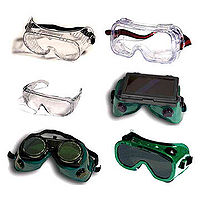Eye Protectors
Employers must first try to eliminate or control the hazard at its source with engineering controls. Eye Protector for example, placing protective housing around laser sources to prevent laser beams from reaching workers’ eyes.
Personal protective equipment (PPE)
When a hazard to the eyes or face cannot be eliminated by the use of engineering controls, suitable PPE must be worn according to the type of work being done.
- The chosen eye or face protector must meet the requirements of the Canadian Standards Association standards CSA - Z94.3 “Eye and Face *Protectors” and CSAZ94.3.1 “Protective Eyewear: A User’s Guide”.
- Prescription glasses with glass lenses do not meet the impact requirements under CSA-Z94.3.1.
- Eyewear with prescription lenses other than glass must:
o have lenses with a minimum thickness of 3.0 mm (1/8”), unless they are manufactured to meet the requirements of the standard. o have lenses that meet the size requirements specified in the standard o be equipped with permanently attached or removable side shields.
•Approved eye protection must be worn over prescription glasses that do not meet the above requirements. •Contact lenses are not a substitute for proper eye and face protection. •Eye and face protectors must be available in a range of eye, bridge and temple sizes to meet the needs of individual workers. •Employers must provide approved emergency eyewash facilities at any workplace where there is a risk of eye injury from exposure to hazardous chemical substances
